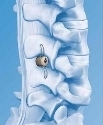by
Joan Trombetti, Writer | December 10, 2008
Singapore's ParkwayHealth is the first healthcare group in Southeast Asia to offer the In-Space percutaneous interspinous distraction device, a revolutionary spinal procedure.
Lumbar spinal stenosis occurs when spinal discs undergo wear and tear from natural degeneration. In the process, the spinal canals are narrowed and nerves can be impinged, causing the typical symptoms of buttock and lower back pain.
Usually, open surgery or laminectomy is necessary to separate the two vertebrae and decompress pressure on the nerve root. However, for suitable patients, a new procedure that involves implantable a device that not only treats the symptoms but spares the patient much discomfort and inconvenience.



Ad Statistics
Times Displayed: 114080
Times Visited: 6783 MIT labs, experts in Multi-Vendor component level repair of: MRI Coils, RF amplifiers, Gradient Amplifiers Contrast Media Injectors. System repairs, sub-assembly repairs, component level repairs, refurbish/calibrate. info@mitlabsusa.com/+1 (305) 470-8013
Developed in Munich, Germany in 2005 and launched in Europe a year later, the In-Space percutaneous interspinous distraction device was designed as a tissue-sparing alternative to the laminectomy. The former only requires a small incision of around 2cm compared to 10cm or bigger for the latter.
With the aid of X-ray imaging, a wire is guided to the space that needs to be widened, and an implant (drum) is railroaded between the affected spinous processes to widen the space between them. Specially-designed metal 'wings' help keep the implant in place by catching onto the adjacent vertebrae.
Unlike a laminectomy, In-Space does not involve the removal of any bone and damaging of any muscles, thus ensuring that the stability of the spine is not compromised in any way.
Since it is a minimally-invasive procedure, patients will not have to tolerate much pain, excessive bleeding or a long hospital stay. Surgery for a single level of vertebrae with a traditional laminectomy would take approximately two and three hours while the In-Space procedure takes under an hour to complete.
Dr. Razmi Rahmat, Consultant Orthopaedic Surgeon at ParkwayHealth's Mount Elizabeth Hospital, is one of a few surgeons in Asia trained to do the procedure, the first carried out in August 2008.
Suitable patients are between 40 and 70 years of age displaying necessary lumbar spinal stenosis symptoms. Not everyone can present as an ideal candidate for In-Space. While leg and buttock pain is a common symptom, the patient needs to feel relief the moment he or she sits down.
The In-Space percutaneous interspinous distraction procedure costs approximately $10,000 for a single level of vertebrae done in Singapore. The devices is still waiting approval in the U.S. by the Food and Drug Administration and is expected to cost at least twice as much as in Singapore.
Back to HCB News

